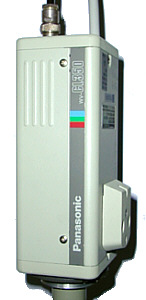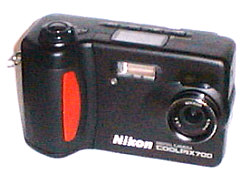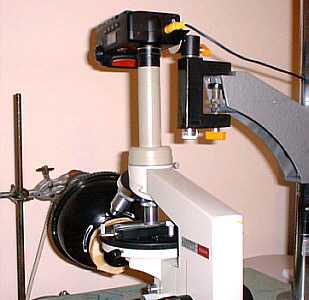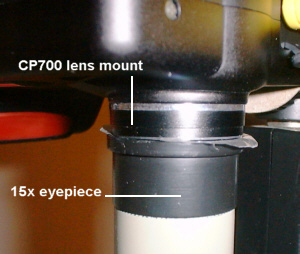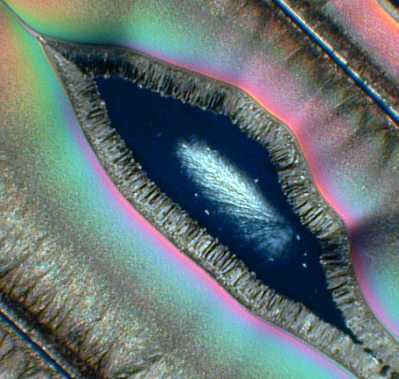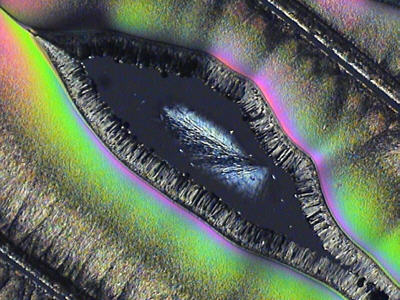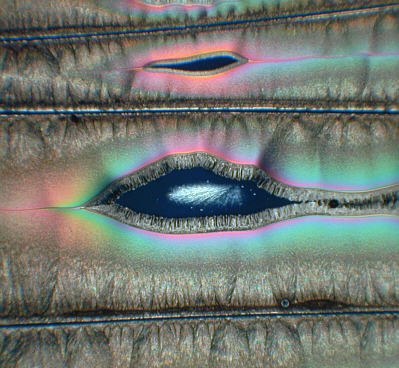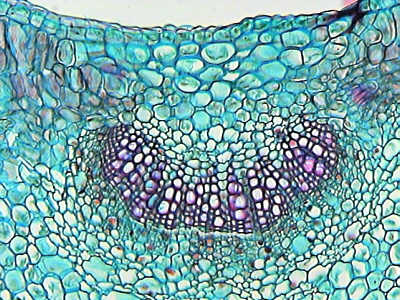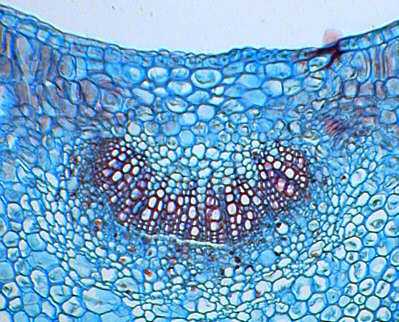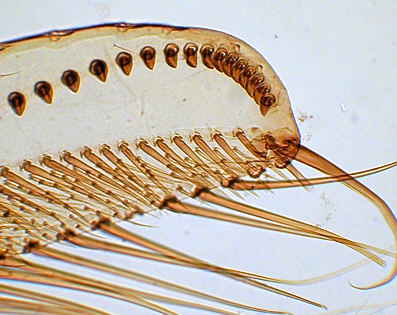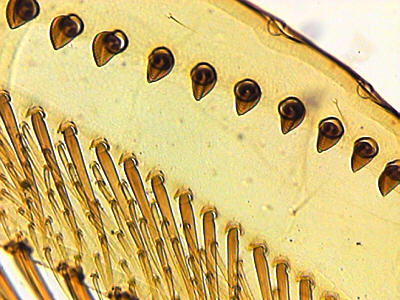I recently had an opportunity to borrow a Nikon Coolpix 700 digital camera. The Coolpix 950 (with 3x optical zoom) is becoming popular for microscopy but I hadn't seen any reports on the use of the fixed focal length Coolpix 700 in this role. So in case of interest I share some quick trials below.
The Nikon images are
compared with stills captured from the colour video camera I
currently use (and a popular image capture route). The
author's requirements as a hobbyist for image capture are
modest, so this article just compares the ease of the two
routes for creating Web images with some remarks on
subjective image quality. The two image capture routes
probably differ too much for meaningful technical comparisons
(which is beyond the author's scope anyway).
'In the blue corner': a Panasonic CL350 video camera (430 horiz. line pair resolution, 681x582 pixel sensor) with 'C' mount adaptor coupled to the microscope eyepiece tube (no eyepiece). Video still capture with a 'Snappy 2.0' using 'Highest quality still mode' at 640x480 pixels. |
'In the red corner': the Coolpix 700. The camera has the same image sensor as the Coolpix 950 (i.e. 1600x1200 pixels). Perhaps not a fair comparison to the video camera left when based on sensor specifications (see footnote), but a comparable video camera/capture card to that left probably sells for a similar price to the CP700 in the UK at the time of writing. |
The
author used the modest Russian Biolam microscope with the
older pre-DIN Russian achromatic objectives (i.e. plan 3.5x
and 9x). The general set-up is
shown below. Further details including preferred camera
settings are included in an Appendix for interested readers.
A new use for an old photo-enlarger. The base and pillar for camera support, and the ventilated enlarger head with field iris on a lab retort stand is already the author's main microscope lamp. (The 65W tungsten enlarger lamp does run a tad hot but is never left unattended). The video out socket on the camera gives a live sensor view. (See 'Focusing' in Appendix). |
The CP700 lens mount diameter is very close to that of a standard microscope eyepiece and helps to roughly align the optical axis of the camera to the microscope and to level the camera. A roundel of tape in between avoided scratching either of the mounts. The lens on the CP700 is behind a glass plate. The first lens element is ca. 5mm behind the front surface of the lens mount (approx. where the silver line on the mount is shown above) and may be partly why vignetting was hard to cure (see below). |
Vignetting
Vignetting - very often the crux as to how useful a digital camera will be for photomicrography! The vignetting was minimised (or incomplete illumination of the vignetted field) for the Russian Biolam using a 15x Kellner Russian eyepiece with the CP700 camera mount butted against the microscope eyepiece mount. (High eyepoint eyepieces may work better but I don't possess one). Vignetting/illumination was worse with lower power eyepieces or if the camera was moved further away from the eyepiece. I tried assorted optics to hand to act as a relay lens between eyepiece and camera but couldn't reduce the vignetting further. This is a pity as the sensor's two megapixels aren't been fully exploited. The video camera scores a significant advantage here as the image fills the frame and only captures a third of the field which is ideal for the Russian microscope's modest optics.
Focusing
The CP700's autofocus (which
uses a 'contrast detection' method) coped well with bolder
subjects by focusing on the aerial image from the eyepiece
(with the 'scope pre-focused for normal viewing). The
autofocus struggled with lower contrast images e.g. diatoms
in bright-field, where the camera's manual focus set at 10cm
worked better with microscope focus checked on the LCD panel
in zoom mode (see Appendix).
Image gallery
These are simple side by
side comparisons of ca. 400x400 web images that the author
requires for Web use. The CP700 vignetted 1600x1200 images
were cropped square and resized unless otherwise stated. The
video camera 640x480 captures were just resized using
'Smartsizing' in Picture Publisher v7.0. Resizing softens an
image so 'level 2-5' sharpening to restore close to the
original sharpness without over sharpening was used for both
routes. Compression ca. 8:1. All CP700 images were taken
using the self-timer to minimise vibration.
Coolpix 700 |
Video camera |
Vitamin C, 3.5x objective. Crop from full capture below to compare with field the video captures right. Master image a bit flat, so tonal balance adjusted to match video image. |
Same slide, 3.5x objective. No tonal balance tweaks as the video camera tends to give over contrasty images. A rather gritty look cf the smoother image left (and tends to lose some highlights e.g. compare white feathering detail). Colours can't be compared as critically dependent on crossed polar positions. |
|
Image left, CP700 full capture (3.5x objective) after cropping vignetted image and resizing. |
CP700 full image capture showing extent of vignetting. Privet leaf (T/S section stained Safranin + Fast Green), 9x objective. The auto white balance gives a warm look. The largest square crop to remove vignetting is ca. 900x900 pixels from the original 1600x1200. |
Full image capture from video i.e. captures ca. one third of visual field so no vignetting. Auto white balance of the video camera copes better than the Coolpix with lamp used, saving post image processing. |
|
Image
left: image from CP700 cropped to compare with the
video image above right. The manual white balance or
incandescent setting was bluish with the 65W tungsten
enlarger lamp used. Further trials with filters,
white balance etc. on the CP700 are needed to find
the ideal for different subjects and lighting. A
tungsten halogen source may be better with auto white
balance. The default 'matrix' exposure metering seemed to cope well on the CP700. Sharpness can't be compared too closely with the image above (or other images shown here), because of resizing. |
CP700 capture. Vegetarian water boatman leg, (Corixa, 1st leg, male, 9x objective to give similar field to video camera). Crop of master, some resizing and tonal balance adjustment. Manual white balance of the empty field before taking the picture gives a better colour balance than the auto white balance. |
Full image capture from video camera. 3.5x objective to give similar field. Auto white balance. The video capture is warm/yellowish and the CP700 bluish. For scientific images accurate color is vital, but for many subjects the colour is to some extent a personal preference which can be tweaked in image processing software. |
General impressions
From the short trials, the Coolpix 700 certainly gives good images from a microscope - acceptable to an amateur microscopist like the author at least. A good workaround to remove the vignetting wasn't found, so only ca. 900x900 of the 1600x1200 pixels available were exploited. The fixed focal length of the Coolpix 700 may be a detriment for photomicrography as a camera with zoom lens (e.g. the Coolpix 950) offers a potential route for removing the vignetting (see web link below).
For image captures of many subjects for a web article - the overall convenience, greater ease of use and lack of vignetting of the existing video camera set-up makes video still capture the preferred route for the author. For images where the finest detail has to be retained e.g. for large screen images or prints, the greater pixel count of the CP700 would show its benefits. Although this extra detail can often be attained with the modest video camera by increasing the 'scope magnification or increasing the camera extension.
It should be pointed out that it's the CP700 in combination with a modest Russian microscope set-up and DIY lighting that has been assessed. Another set-up with the availability of suitable relay lenses, quick mechanical attachment or support, different lighting etc. may better exploit the potential of the CP700 for photomicrography.
Consumer digital cameras are primarily bought for normal photography, so if a presently owned 'digicam' suits for photomicrography it's a bonus.
Comments to the author Dave Walker welcomed.
Acknowledgements
Thanks to my brother Ian
for bravely loaning the Coolpix 700. Thanks to Mike Samworth
who prepared the excellent Vitamin C slide. Other prepared
slides were sourced from Northern Biological Supplies. Thanks
to Paul James and Ron Neumeyer for comments on the article. General
discussions on video and still camera CCD sensor technology
with Ted Clarke are also appreciated. (Any errors above are
the authors!)
There's some excellent web
sites giving detailed reviews of the current crop of
'digicams' for normal picture taking. These provided useful
background info', and if choosing a digital camera with half
an eye on its use over a microscope, they may give some clues
as to its suitability from the lens mounts, camera layout and
foibles. Notable web sites are: Digital
Photography Review, Imaging Resource and the monthly on-line magazine Megapixel.net.
Web resources of
interest
A fascinating illustrated article by Dr. David Yan on his
experiences of using the Coolpix 900 and 950 for
photomicrography is at http://www.wisc.edu/genetics/micro/.
Appendix
Coupling the CP700 to the microscope: The CP700 has a sturdy metal lens mount with 24mm filter thread which lends itself to DIY couplings to the microscope. The enlarger pillar used here rotates, allowing the camera to be swung out of the way for setting-up the microscope, then swung back to quickly re-establish alignment for image capture.
Final alignment, which has to be millimeter perfect, was accomplished by inspecting the field of view circle on the CP700 LCD panel. I found it difficult to level the camera by eye. A small cube-shaped spirit level (available from photo outlets) gently sat on the LCD panel would be handy for camera levelling.
Nikon can supply as an accessory a 24-28mm step-up ring (code UR-E1) for the CP700. This allows the 28mm to camera 'T' mount available for the CP950 to be used, which in turn could be connected to a standard microscope camera adaptor with 'T' mount. However, although this would give a sturdy mechanical coupling to a microscope it would place the CP700 lens some distance from the microscope eyepiece. For the Russian set-up above (and possibly for some other microscopes) the camera lens has to be as close to the 'scope eyepiece as possible.
Camera settings: The CP700 has a variety of controls - manual/auto focus, under/over exposure (EV) control, manual/auto white balance and three metering methods. It would take some time to identify the best set-up for different types of photomicrography, so for these trials the default camera settings were used in the main i.e. autofocus, matrix metering, 1600x1200 images, fine compression. The CP700 allows the auto camera shut-off to be set to 30 mins giving plenty of time for trials.
Lighting - the 'microscope lamp' was a 65W photo-enlarger bulb in housing/field iris which gives a good even white field from low to highest power (my preference to a Köhler lamp). This seem well matched to the camera giving exposure settings of f2.6-f8 with 1/30th to 1/125th of a second depending on the microscope objective without the need for neutral density filters. (Unlike the CP950, the CP700 has no control over aperture/shutter selection although the settings selected by the camera are displayed).
Focusing: The CP700's video out signal fed to an external monitor screen can aid fine focus adjustment, although the video quality (unsurprisingly) isn't as good as from the true video camera. The author found critical focusing to be easier with the CP700 using the digital zoom function to bring up a larger image on the camera's LCD for focus checks, and then dropping the zoom back to 1x before taking the picture.
Niggles: The CP700 lens (and plastic threaded tripod bush) is on the far left of the camera with battery weight at the far right. Using the optional mains power supply and leaving the batteries out would improve the weight balance (and strain on the lens mount if used for mechanical coupling).
Also, if the tripod mount is used for a microscope support (as here) the compact flash card can't be removed. This is a serious drawback if 1600x1200 'fine' images are required; the supplied 8MB card will only take ca. 8 images before the card is full, although larger cards would increase the number of image captures. If the microscope/camera is close to the PC the much slower serial cable for image transfer may be preferred to a card reader as the carefully aligned set-up doesn't need to be dismantled.
Technical footnotes: 1) The image comparisons between the CP700 and video stills above were purely on subjective image quality. The CP700 uses a still image CCD sensor where the 'resolution' is often reported by makers just in terms of the number of pixels on the sensor. Whereas video camera sensor resolution is usually quoted as line pairs per millimeter on a display image rather than pixels on the sensor. The Snappy video still capture card used, like other makers cards, can multiply sample a video signal to give image sizes up to 1500x1125 pixels i.e. comparable to the CP700 native sensor size. Although from my own limited trials, image capture from video stills much above 640x480 i.e. near the native pixel count of the CL350 video camera sensor seems to give empty magnification with the author's modest microscope set-up.
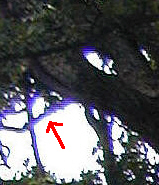
2) The 'blue/purple fringing' problem. Some 1600x1200 digital cameras including the Coolpix 700 exhibit marked colour fringing of some subjects in high contrast areas, which is thought to be in part sensor related rather than lens aberration. My brother who owns the CP700 has found this quite a problem for some normal subjects (see tree branches against a sky, right). Many microscopy subjects are viewed against a bright background, but to date the author hasn't noticed this colour fringing in the limited trials of the CP700 over a microscope. (See http://my.iwarp.com/c2000z for a discussion and fascinating study of this fringing problem for the Olympus C2000z during normal picture taking).
